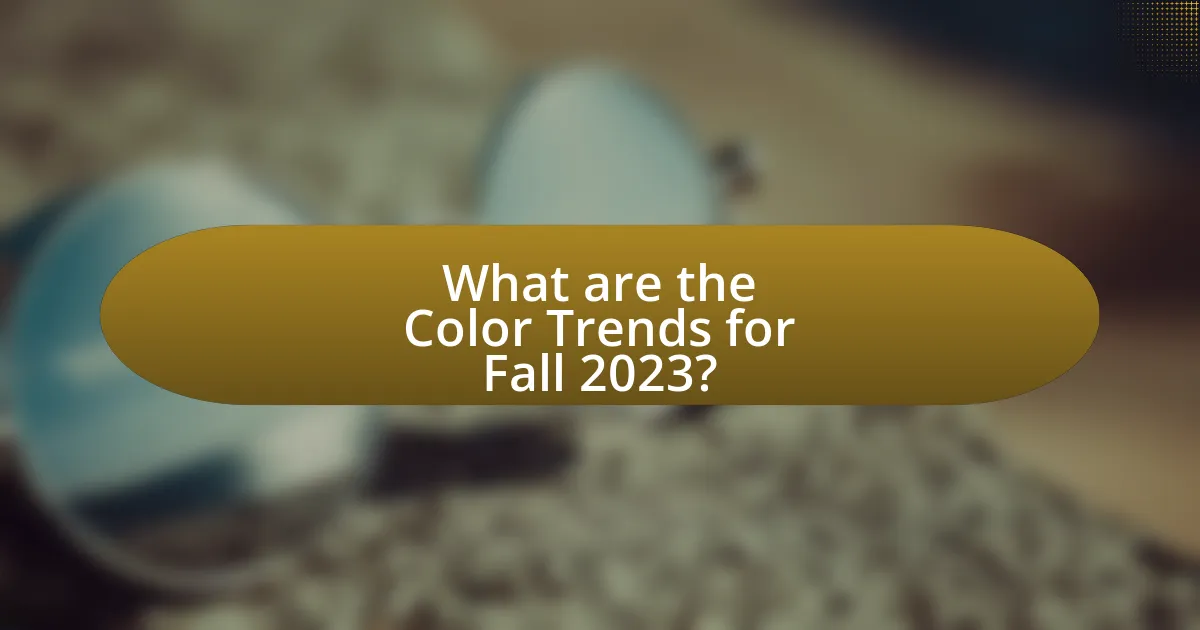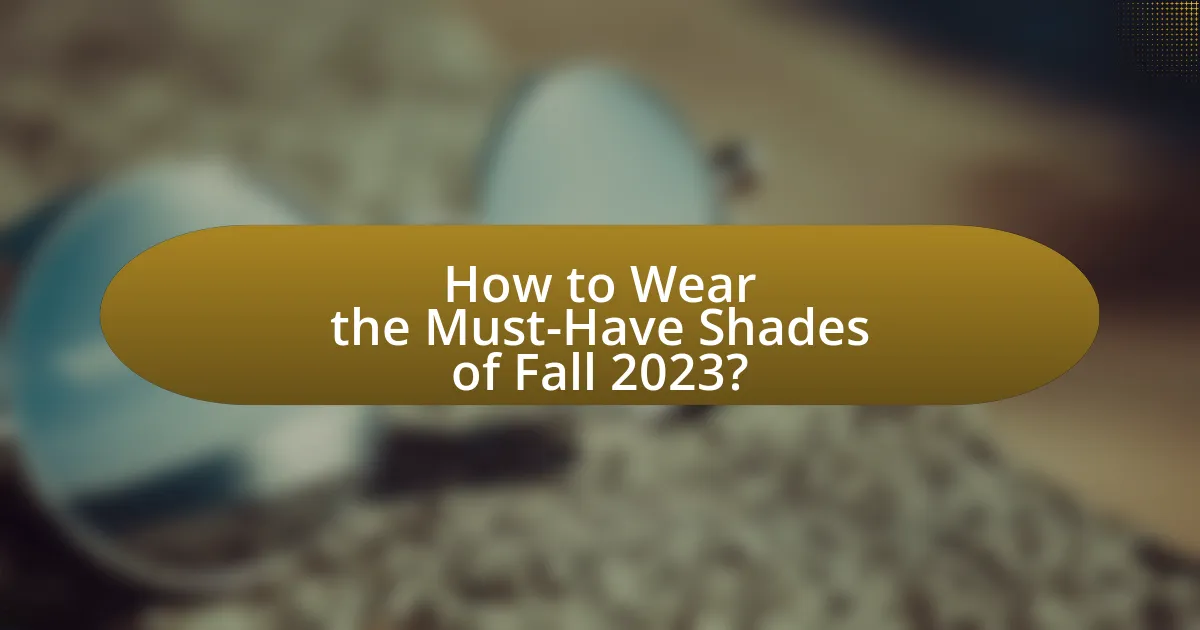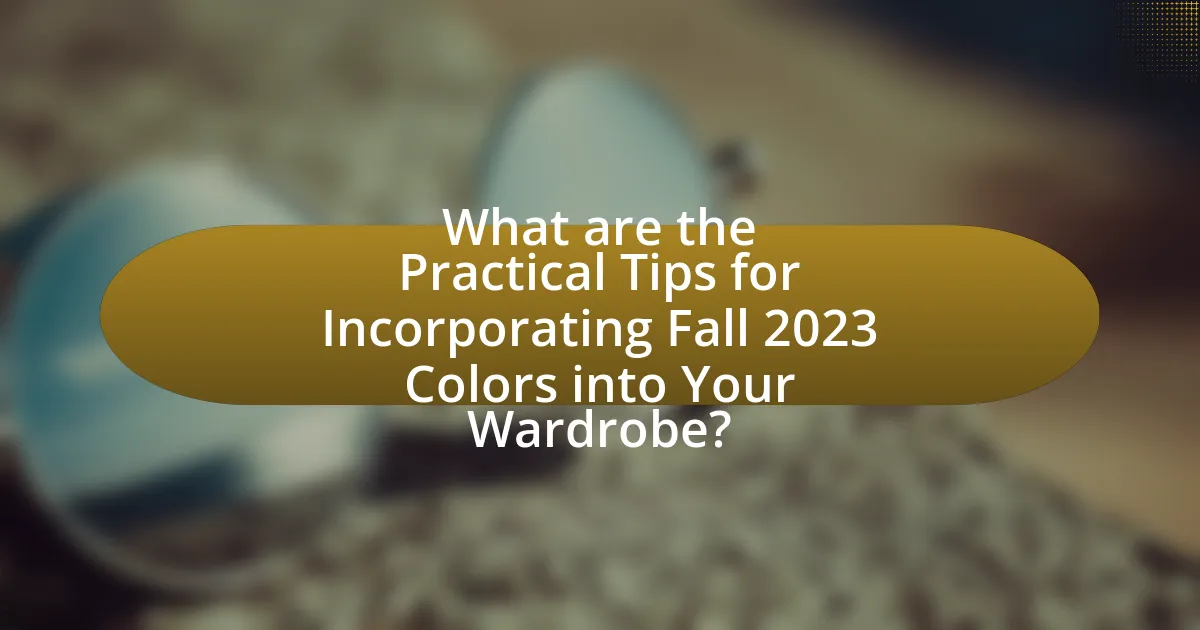The article focuses on the color trends for Fall 2023, highlighting must-have shades such as deep burgundy, rich emerald green, and burnt orange. It explores how these colors influence fashion choices, the historical and cultural factors that shape current trends, and the importance of understanding color preferences in relation to personal style. Additionally, the article provides practical tips for incorporating these colors into wardrobes, including layering techniques, mixing and matching outfits, and avoiding common mistakes. Overall, it serves as a comprehensive guide to navigating the seasonal color palette effectively.

What are the Color Trends for Fall 2023?
The color trends for Fall 2023 include rich jewel tones, earthy neutrals, and vibrant accents. Specifically, shades like deep emerald green, burnt orange, and warm taupe are prominent, reflecting a blend of nature-inspired hues and bold statements. This trend is supported by fashion forecasts from industry leaders, indicating a shift towards colors that evoke warmth and comfort, aligning with consumer preferences for cozy aesthetics during the fall season.
How do color trends influence fashion choices?
Color trends significantly influence fashion choices by dictating the hues that dominate collections and consumer preferences each season. Designers often align their creations with prevailing color trends, as seen in the Pantone Color Institute’s annual forecasts, which highlight colors that resonate with cultural moods and societal shifts. For instance, the 2023 color palette emphasizes earthy tones and vibrant shades, reflecting a collective desire for comfort and optimism post-pandemic. This alignment drives retailers to stock items in these trending colors, thereby shaping consumer purchasing decisions and ultimately impacting overall fashion trends.
What historical factors shape current color trends?
Historical factors that shape current color trends include cultural movements, technological advancements, and economic conditions. For instance, the rise of the digital age has influenced color palettes through the prevalence of vibrant, saturated colors seen in digital media and advertising. Additionally, historical events such as the 1960s counterculture movement introduced bold colors as symbols of rebellion and freedom, which continue to resonate in contemporary fashion. Economic factors, such as recessions, often lead to a preference for muted, neutral tones as consumers seek comfort and stability. These influences collectively inform the color choices seen in fashion and design today.
How do cultural influences affect color preferences?
Cultural influences significantly affect color preferences by shaping the meanings and associations attached to specific colors within different societies. For instance, in Western cultures, white is often associated with purity and weddings, while in many Eastern cultures, it symbolizes mourning and funerals. Research indicates that these cultural contexts can lead to varying emotional responses to colors; for example, a study published in the Journal of Cross-Cultural Psychology found that individuals from collectivist cultures tend to prefer colors that promote harmony and community, such as blue and green, while those from individualistic cultures may favor more vibrant colors like red and yellow that express personal identity. Thus, cultural backgrounds play a crucial role in determining which colors are favored and how they are perceived.
What are the must-have shades for Fall 2023?
The must-have shades for Fall 2023 include deep burgundy, rich emerald green, warm caramel, and classic navy blue. These colors reflect the seasonal shift towards warmer tones and are versatile for various styles. Deep burgundy offers a bold statement, while rich emerald green adds a touch of sophistication. Warm caramel provides a cozy feel, and classic navy blue remains a timeless choice for layering. These shades align with fashion forecasts that emphasize earthy and jewel tones for the season, making them essential for a stylish fall wardrobe.
Which colors are predicted to dominate this season?
This season, the colors predicted to dominate are rich jewel tones, earthy neutrals, and vibrant shades of red and orange. Specifically, colors like emerald green, deep burgundy, and burnt orange are highlighted as key trends for Fall 2023. These shades reflect a shift towards warmth and depth, aligning with the seasonal transition and the desire for comfort in fashion. The emphasis on jewel tones and earthy hues is supported by fashion forecasts from industry leaders, indicating a strong preference for colors that evoke a sense of coziness and sophistication during the fall months.
How do these shades complement seasonal fabrics?
These shades enhance seasonal fabrics by creating visual harmony and depth, which is essential for fall aesthetics. For instance, warm tones like burnt orange and deep burgundy pair well with rich textures such as wool and cashmere, adding warmth and sophistication. Additionally, earthy shades like olive green complement natural fibers, enhancing the organic feel of autumn clothing. This synergy between color and fabric not only elevates the overall look but also aligns with the seasonal mood, making outfits more cohesive and appealing.
Why is it important to understand color trends?
Understanding color trends is important because they influence consumer preferences and purchasing decisions in fashion and design. For instance, the Pantone Color Institute identifies trending colors each season, which brands often adopt to align with market demands. This alignment can enhance brand relevance and appeal, as seen in the increased sales of products that incorporate these trending colors. Additionally, awareness of color trends allows designers and marketers to create cohesive collections that resonate with current aesthetic values, ultimately driving engagement and sales.
How can color trends enhance personal style?
Color trends can enhance personal style by providing a framework for individuals to express their identity and creativity through their wardrobe choices. By incorporating trending colors, such as those identified for Fall 2023, individuals can align their outfits with contemporary aesthetics, making their style more relevant and visually appealing. Research indicates that color can influence perceptions and emotions; for example, wearing vibrant colors can evoke feelings of confidence and positivity. Thus, adopting current color trends not only updates a personal style but also enhances the overall impact of one’s appearance in social and professional settings.
What role do color trends play in the fashion industry?
Color trends play a crucial role in the fashion industry by influencing design choices, consumer purchasing behavior, and brand identity. Designers often use color trends to create collections that resonate with current cultural moods and societal shifts, ensuring their offerings are relevant and appealing. For instance, the Pantone Color Institute releases a Color of the Year, which significantly impacts fashion collections globally, as seen with the popularity of Very Peri in 2022, which guided many designers’ palettes. Additionally, color trends can drive sales; research indicates that 85% of consumers make purchasing decisions based on color alone, highlighting the importance of color in attracting buyers.

How to Wear the Must-Have Shades of Fall 2023?
To wear the must-have shades of Fall 2023, incorporate rich hues like deep burgundy, forest green, and burnt orange into your wardrobe. These colors can be paired with neutral tones such as beige or gray to create balanced outfits. For example, a deep burgundy sweater can be matched with gray trousers, while a forest green jacket can complement a white shirt and dark jeans. Layering these shades with accessories like scarves or hats in similar tones enhances the overall look. Fashion experts highlight that these colors not only reflect the seasonal palette but also evoke warmth and sophistication, making them ideal for autumn styling.
What are the best combinations for this season’s colors?
The best combinations for this season’s colors include deep burgundy paired with warm mustard, rich forest green combined with soft taupe, and vibrant teal alongside muted peach. These combinations reflect the Fall 2023 color trends, which emphasize warmth and earthiness. For instance, the pairing of deep burgundy and warm mustard creates a striking contrast that is visually appealing and seasonally appropriate, while rich forest green and soft taupe evoke a natural, cozy feel. Vibrant teal and muted peach offer a refreshing yet harmonious balance, making them ideal for layering in outfits. These combinations are supported by fashion forecasts from industry leaders, indicating a shift towards bold yet grounded color palettes this season.
How can contrasting colors be effectively paired?
Contrasting colors can be effectively paired by utilizing the color wheel to identify complementary colors, which are located opposite each other. For instance, pairing blue with orange or red with green creates a vibrant visual impact. This method is supported by color theory, which suggests that complementary colors enhance each other’s intensity, making designs more dynamic. Additionally, balancing the saturation and brightness of the colors can prevent overwhelming visuals; for example, a bright orange can be paired with a muted blue to achieve harmony while maintaining contrast.
What accessories enhance the chosen color palette?
Accessories that enhance the chosen color palette for Fall 2023 include scarves, handbags, and jewelry that complement the trending shades. For instance, if the palette features warm tones like burnt orange or deep burgundy, accessories in neutral colors such as beige or cream can provide balance. Additionally, metallic accents in gold or bronze can add sophistication and tie together the overall look. Studies in fashion trends indicate that accessories play a crucial role in elevating outfits by providing contrast and depth, thus reinforcing the importance of selecting the right accessories to enhance the chosen color palette.
How can different body types wear these colors?
Different body types can wear colors effectively by choosing shades that complement their specific shapes. For example, individuals with an hourglass figure can enhance their curves by wearing bold, vibrant colors that draw attention to their waist, while those with a rectangular body type may opt for softer, pastel shades to create the illusion of curves. Additionally, pear-shaped individuals can wear darker colors on the bottom to minimize the hips, pairing them with brighter colors on top to draw the eye upward. Research indicates that color can influence perception of body shape; a study published in the Journal of Fashion Marketing and Management found that certain colors can enhance or diminish body proportions in the eyes of observers. Thus, understanding how to utilize color in relation to body type can significantly impact overall appearance and confidence.
What shades are most flattering for various skin tones?
Warm skin tones are most flattered by shades like coral, peach, and warm reds, while cool skin tones look best in shades such as berry, plum, and cool pinks. Neutral skin tones can wear a mix of both warm and cool shades, including soft taupes and blushes. This categorization is supported by color theory, which indicates that complementary colors enhance natural skin undertones, making the overall appearance more vibrant and harmonious.
How can individuals choose colors that suit their personal style?
Individuals can choose colors that suit their personal style by identifying their skin tone, personal preferences, and the emotional impact of colors. Understanding whether one has a warm, cool, or neutral skin tone helps in selecting shades that enhance natural features; for instance, warm tones often look best in earthy colors like oranges and yellows, while cool tones are complemented by blues and purples. Additionally, individuals should consider their personal preferences and lifestyle, as colors that resonate with one’s personality can boost confidence and self-expression. Research indicates that colors can evoke specific emotions, influencing mood and perception; for example, blue is often associated with calmness, while red can signify energy. By combining these factors, individuals can effectively curate a color palette that aligns with their unique style and enhances their overall appearance.

What are the Practical Tips for Incorporating Fall 2023 Colors into Your Wardrobe?
To incorporate Fall 2023 colors into your wardrobe, focus on layering pieces in rich hues like deep burgundy, forest green, and burnt orange. Start by selecting a few key items, such as sweaters or jackets, in these colors to serve as statement pieces. Pair these with neutral basics to balance the look, ensuring that the vibrant colors stand out. Accessorizing with scarves, hats, or bags in complementary shades can also enhance your outfit without overwhelming it. According to color trend reports, these shades are not only fashionable but also evoke the seasonal ambiance, making them ideal for fall styling.
How can you transition your wardrobe for the fall season?
To transition your wardrobe for the fall season, incorporate layers and rich, warm colors that reflect the seasonal palette. Start by adding lightweight sweaters, cardigans, and long-sleeve tops in shades like burnt orange, deep burgundy, and mustard yellow, which are trending for Fall 2023. Additionally, swap out summer fabrics for heavier materials such as wool and flannel to provide warmth and texture. This approach aligns with the seasonal color trends, ensuring your wardrobe is both stylish and functional for cooler weather.
What layering techniques work best with these colors?
Layering techniques that work best with the colors trending for Fall 2023 include tonal layering, where different shades of the same color are combined to create depth, and contrasting layering, which involves pairing bold colors with neutrals to enhance visual interest. Tonal layering allows for a sophisticated look that maintains a cohesive color palette, while contrasting layering adds vibrancy and can highlight specific pieces in an outfit. These techniques are effective because they utilize the rich, warm hues popular this season, such as deep burgundy and mustard yellow, which can be layered in various textures to create dimension and style.
How can you mix and match to create versatile outfits?
To create versatile outfits, combine staple pieces with trendy items while ensuring color coordination. For instance, pairing neutral basics like a white shirt or black trousers with seasonal colors such as deep burgundy or olive green allows for a range of looks. This method leverages the versatility of neutral tones, which can be easily matched with various colors, patterns, and textures, enhancing the overall outfit’s adaptability. Studies in fashion psychology indicate that color combinations can influence perceptions and moods, making strategic mixing and matching not only practical but also impactful in personal style.
What are common mistakes to avoid when wearing fall colors?
Common mistakes to avoid when wearing fall colors include clashing hues, overloading on patterns, and neglecting skin tone compatibility. Clashing hues can create a disjointed look; for example, pairing bright orange with deep burgundy may not harmonize well. Overloading on patterns can overwhelm the outfit, making it difficult to focus on the fall colors themselves. Additionally, neglecting skin tone compatibility can lead to unflattering appearances; warm tones like mustard may not suit cooler skin tones. These mistakes can detract from the overall aesthetic and effectiveness of fall color palettes.
How can you ensure your outfit remains cohesive?
To ensure your outfit remains cohesive, select a color palette that harmonizes throughout your clothing and accessories. For example, using shades that complement each other, such as earthy tones or monochromatic colors, creates a unified look. Research indicates that outfits with a limited color scheme are perceived as more stylish and intentional, as seen in studies on color theory and fashion psychology.
What should you consider when selecting patterns with fall colors?
When selecting patterns with fall colors, consider the harmony between the colors and the overall mood you want to convey. Fall colors typically include warm tones like deep reds, burnt oranges, and golden yellows, which evoke feelings of coziness and warmth. Patterns that incorporate these colors should complement each other and reflect the seasonal aesthetic. For example, plaid and floral patterns in these hues can enhance the autumn vibe. Additionally, consider the scale of the pattern; larger patterns can create a bold statement, while smaller patterns may offer a more subtle look. This approach aligns with the trend of using layered textures and patterns in fall fashion, as seen in various fashion shows and collections for Fall 2023.

Leave a Reply